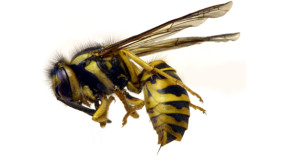Entomologists often walk a fine line between sounding alarmist and underplaying the importance of pest problems. Africanized honey bees and children are a good example.
The potential seriousness of living with these bees was underscored yesterday when a gym class of middle schoolers disturbed a bee hive in a water controller box on a campus soccer field. According to news accounts, 20 students were stung, and several were taken to the hospital. Presumably the bees in this case were Africanized.

Honey bee nests are usually hidden inside a tree or wall, but occasionally bees will build an exposed hive, like this one hanging from a tree. It’s best to stay away from any bee hive, or wherever you see bees entering and exiting a hole in the ground, or in a tree or building.
Coincidentally this month, BBC News magazine interviewed Texas A&M entomologist, Dr. Juliana Rangel, about what it is that makes the Africanized honey bee (AHB) so dangerous. She summarized the challenge by noting that the AHB is “more aggressive and more easily agitated than other bees. The banana-scented pheromone they release – the one that tells the rest of the colony to join in the attack – can be detected across a wider radius” than our domesticated European strain of honey bee. Although any honey bee nest can be dangerous, she said that the AHB is likely to send more bees out to defend its nest. And the defenders will chase a victim farther than our domestic bees.
The AHB entered Texas almost 25 years ago and has since spread across the state, hybridizing with our feral European honey bee population. It’s best to assume that any wild bee hives you see in your back yard or park are Africanized and worthy of respect.
Bee stings can be much more than just a painful experience. About 1% of people experience more serious reactions to bee or wasp venom, requiring a visit to the emergency room. For this reason, it’s important to be ready with some instruction to your children about bees.
While most kids can handle dozens to even hundreds of stings, the experience is not fun, and will likely be traumatic for some children. And for allergic kids (and adults), even a few stings can be deadly. A few things you and your children should know about bees:
- Run if you encounter bees that sting you! Run straight to shelter like a car or building where you can close a door. Don’t jump into a pool or other water. The bees will not go away quickly, and people who jump in water usually get more stings.
- Bees usually leave a stinger in your skin after an attack. Gently scrape out the stingers, and you will get less venom and it won’t hurt as much. If it makes you feel better, all bees that leave their stingers in your skin die soon, and cannot sting again.
- It’s normal for bee stings to hurt, and even swell a little, where you are stung. But if your whole arm or leg or throat or face starts to hurt or swell let an adult know right away. If you start to itch all over, or get red bumps (hives) on different places on your body, or if you have difficulty breathing, don’t panic. But it is important to find an adult to help you get to a doctor or nurse right away.
- Parents, Benadryl™ is a good first aid measure to help slow the allergic response and relieve swelling. Also, a child’s dosage of an analgesic like Tylenol or Advil can help relieve the temporary pain associated with bee stings.
- Don’t be afraid of bees on flowers or around trash cans (where they are looking for sweets). The only time bees are likely to sting, is if you get too close to their nest.
- Yellowjacket wasps are small, yellow and black wasps that nest in the ground. Their nests are even more common than bee nests in the fall. Learn what yellowjacket wasps look like and avoid them like bees.
Although bees are good for our crops and gardens, and 99% of the time cause absolutely no harm, the risk from bees is real. I’m not exaggerating. So kids and parents, bee careful out there.

